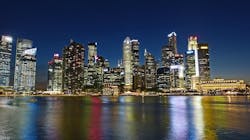In Singapore, researchers are planning to build a pilot membrane filtration plant to treat industrial wastewater. According to The Chemical Engineer, the plant will allow a semiconductor company to reduce liquid waste by more than 90% and allow it to recover metals from treated water which could then be reused and sold.
The pilot plant will use a novel water treatment system that employs a novel type of hollow-fibre membrane (HFM) invented by Neal Chung, Professor at the National University of Singapore (NUS). According to The Chemical Engineer, HFMs are a class of artificial membranes that contain a semi-permeable barrier in the form of hollow fibre. Conventional HFMs have a single hollow core, but Chung’s tri-bore HFMs contain three hollow cores, increasing water flow rate by about 30%.
The plant will be located at a semiconductor factory in Singapore, which currently transports toxic wastewater produced during manufacturing to a wastewater disposal facility for incineration. According to The Chemical Engineer, this process uses five times the energy cost expected for the pilot plant. The semiconductor company is expected to save 1.6m L/y of water, allowing it to save approximately $187,277 in disposal costs.
According to The Chemical Engineer, commissioning of the plant is expected in the second quarter of 2019. The plant will be built by the Separation Technologies Applied Research and Translation (START) Centre and Memsift Innovations, under a new research partnership.
The companies will use the results to commercialize the technology, which will be a step towards a circular economy, according to The Chemical Engineer. Waste will then be turned into resources, and water will be recycled for industrial purposes, helping Singapore to conserve its clean water supply.
If the pilot is successful, Memsift will obtain a full license from NTUitive and commercialize it together with its proprietary technologies. According to The Chemical Engineer, the novel technology would also be made available to the members of Singapore’s National Membrane Consortium, SG-MEM. The START Centre is the leading body of SG-MEM, and Memsift is an industry member.
“This pilot plant marks the first of many local water innovations which START is translating for commercialization,” said Adil Dhalla, managing director of the START Centre. “Using our cutting-edge membrane fabrication, module design and testing facilities, we are able to scale up novel technologies from Singapore’s institutes of higher learning rapidly and to test them in real-life environments to validate their commercial value.”


